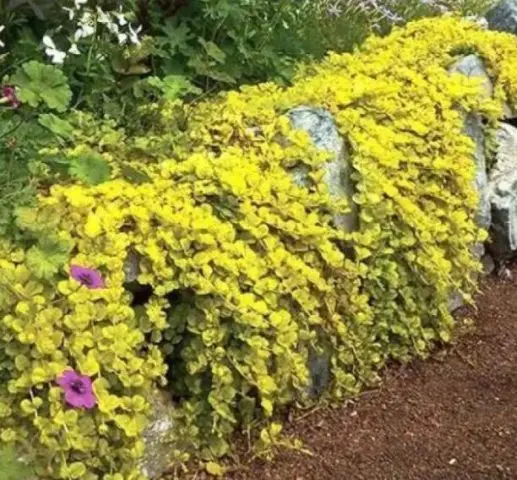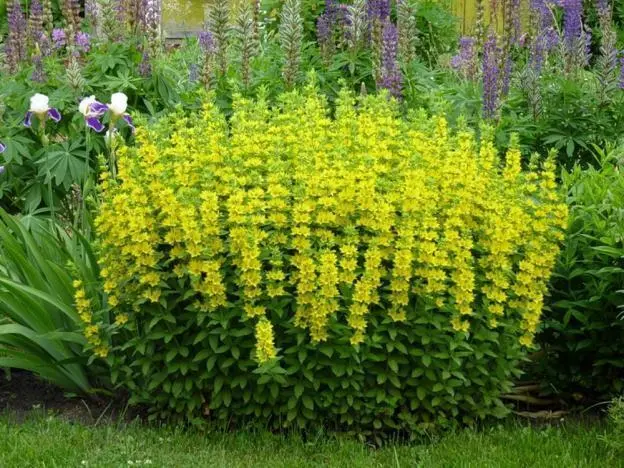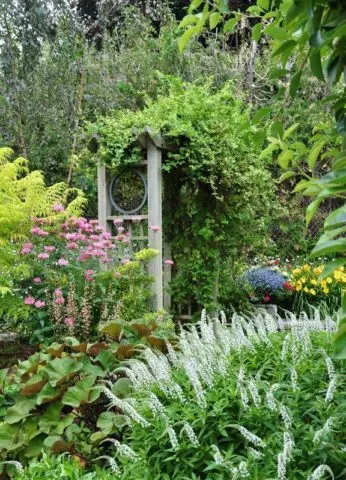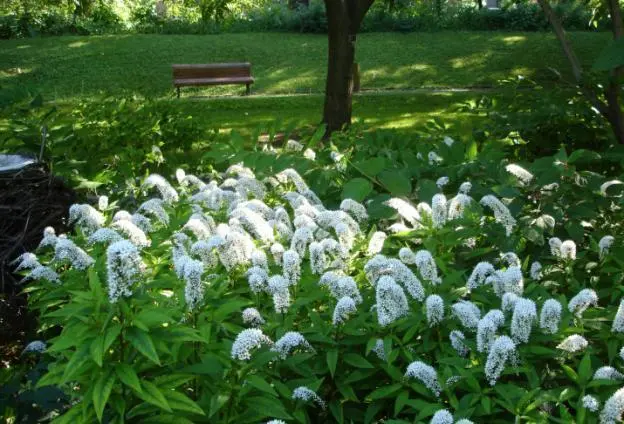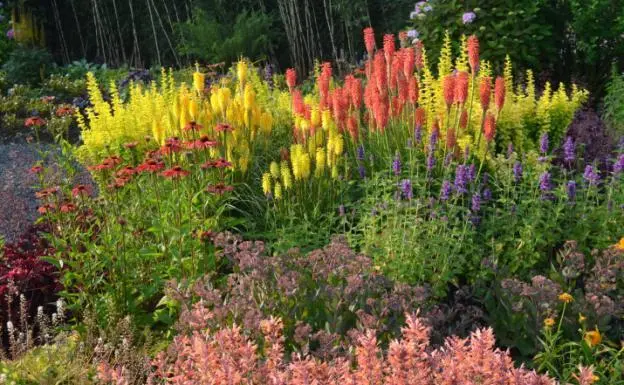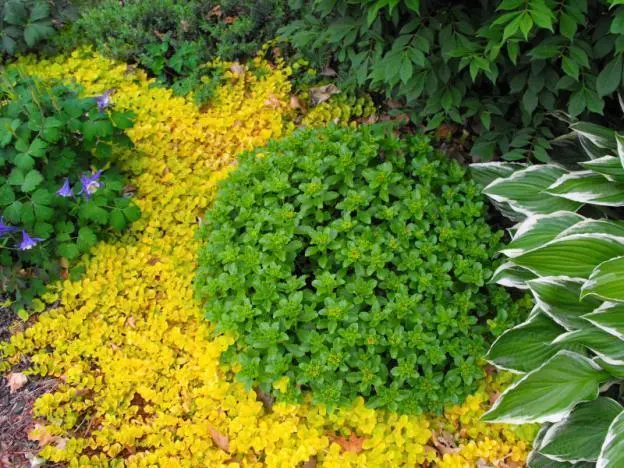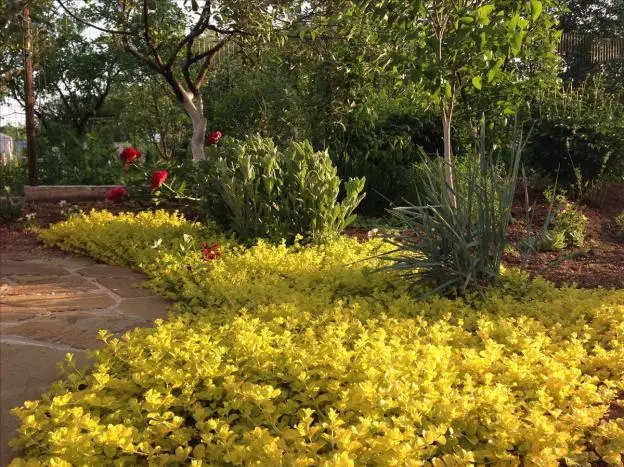Contents
Planting and caring for loosestrife according to all the rules of agricultural technology will become the guarantor of a healthy plant with full vegetation. Culture is grown to decorate the landscape. An unpretentious herbaceous shrub will decorate any composition in the garden. To grow loosestrife (pictured), you must adhere to the planting dates and the rules for caring for the crop.
What does a loosestrife look like
In Our Country, in addition to the common loosestrife, 8 types of culture are found; decorative forms created on their basis are used in horticulture.
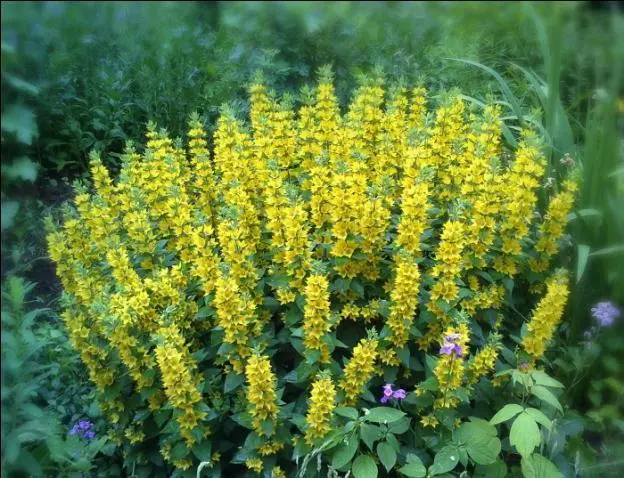
The loosestrife prefers to settle on the waterlogged soil of water meadows, along the banks of reservoirs or in wetlands.
The characteristic of the plant depends on the variety of culture:
- the biological cycle can be annual, biennial or multi-year, the latter being the most common;
- herbaceous plant in the form of a bush with upright stems and drooping tops or ground cover, creeping type;
- leaves are simple, with smooth edges, opposite, whorled or alternate;
- color green, maroon or variegated;
- the fruit is a rounded capsule.
The root system of all species and varieties, powerful, overgrown, creeping type.
When and how loosestrife blooms
Flowering time depends on the variety. This is mainly June – August, the seeds of all varieties ripen in September.
How culture blooms:
- inflorescences are corymbose, paniculate or solitary flowers located in leaf axils;
- color yellow, white or pink;
- cups are five-parted with a bright core.
The culture is characterized by intensive shoot formation, flowering is always plentiful, bush forms are dense, dense.
Types and varieties of loosestrife with a photo
Loosestrife (pictured) is a common plant in Our Country, characterized by a variety of varieties. Each of them has its own flowering period. All representatives are united by the same agricultural technology and biological requirements.
Common loosestrife
The most common species is the common loosestrife, which grows throughout the European part, in the North Caucasus. In the landscape, it is used as an unpretentious field plant to simulate a corner of the wild. Common loosestrife is not used in breeding work.
Characteristics of a herbaceous plant:
- shoots up to 1 m long, hard, pale green, with dense edging;
- leaves are whole, lanceolate, with smooth edges, light green, collected 4 pieces in whorls;
- five-petalled flowers, bright yellow with an orange center, form panicle inflorescences located on the tops of the shoots.
Blooms in mid June. The plant has medicinal properties, so it is used in traditional medicine.
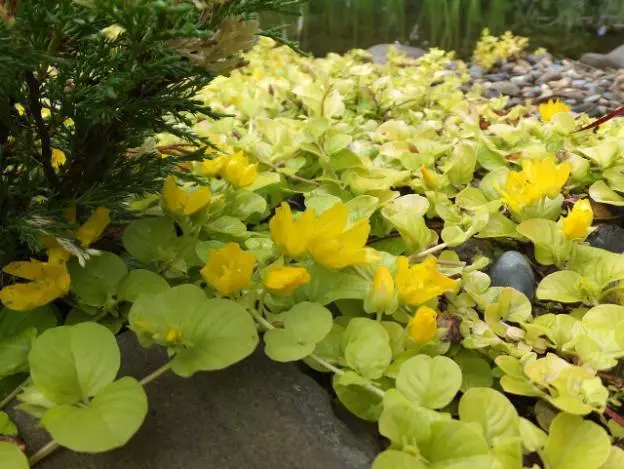
The bush at the common loosestrife is dense, blooms until the beginning of August
Coleman’s coffin
A groundcover variety up to 15 cm high, growing, covers an area up to 60 cm. This is a perennial herbaceous plant with creeping stems. In the leaf axils, root processes are formed, with which the loosestrife is fixed to the surface, quickly takes root, forming a new bush.
External characteristics of the plant:
- the stem is smooth, knotty, completely covered with leaves;
- leaf plates are rounded, opposite, light green;
- flowers are flat, resembling a coin (hence the name of the species), consist of five petals with sharp tops, singly located in the leaf axils;
- the color is bright yellow, the anthers are beige, there is no obvious contrast with the core in tone.
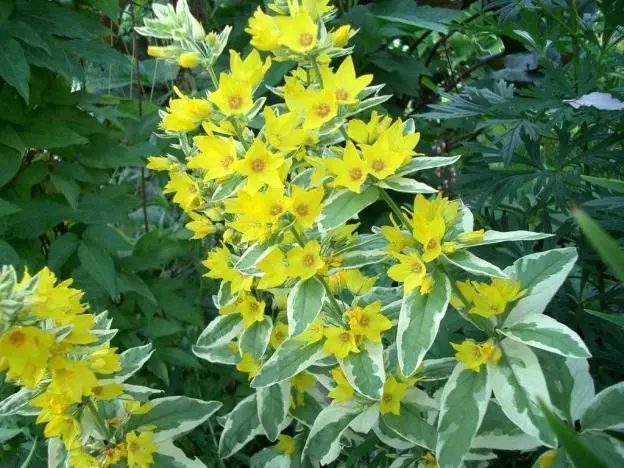
Monet variety blooms from late May to August
Presented in two varieties. Monetary loosestrife Aurea with salad-yellowish leaves. The plant is more prostrate, the length of the stems is up to 30 cm. The flowers are solitary, bright yellow with black patches.

Aurea variety is characterized by abundant flowering, lasting from May to August
Variety Goldilocks (Goldiloks) – ground cover perennial with long creeping stems and golden leaves. The flowers do not differ from a wild plant, the species is valued for its decorative crown.
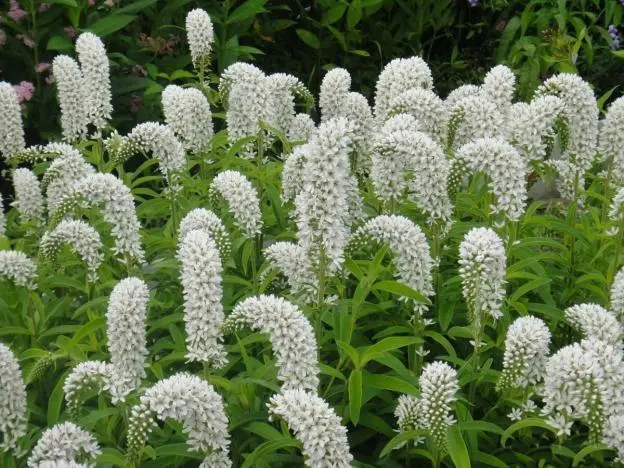
Goldilox is suitable for growing in pots for the purpose of vertical gardening
Verbainik dot
The loosestrife grows in the form of a herbaceous shrub, the height of the stems is 1,2 m. The wild-growing species is characterized by yellow panicle inflorescences with drooping tops. The most common variety in gardens is Alexander. The exotic appearance of the bush is given by the unusual color of light green leaves with a pronounced white border around the edge.
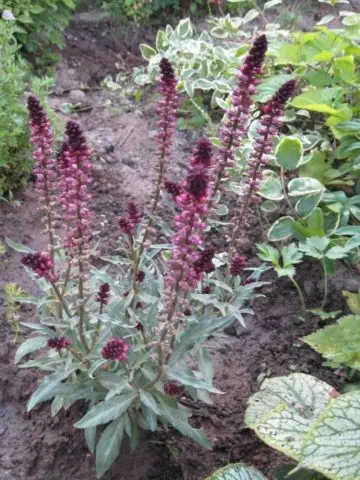
The flowering period of the spotted loosestrife is from mid-June to the second half of August
Variety Goldilocks is a herbaceous shrub up to 1,3 m high with spike-shaped drooping inflorescences. It resembles curls of hair, hence the unusual name. The flowering of the variety is not too long, the first buds open in June, they do not bloom at the same time, so the process continues until the end of July.
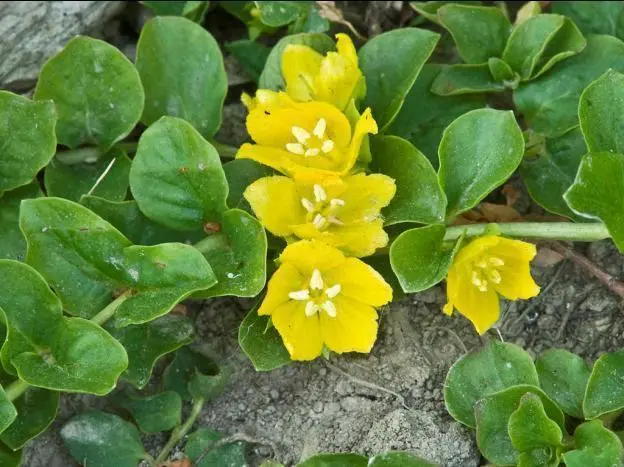
The flowers are large, orange, with a dark red or burgundy core.
loosestrife
Perennial herbaceous shrub found in the wild. It has an unattractive appearance. The bush is loose, the flowers are yellow, collected in paniculate, rarely located inflorescences. The leaves are lanceolate with a brown tint.
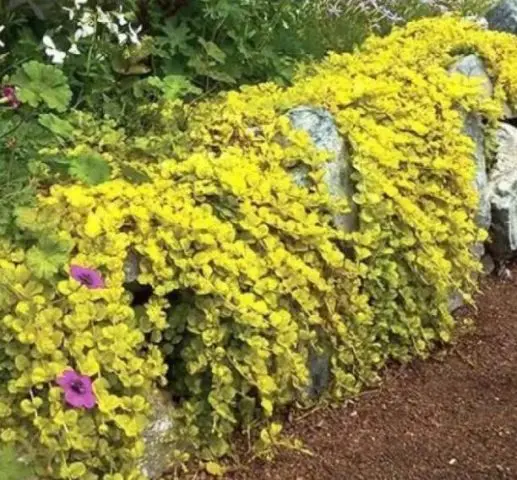
Often found along the edge of swamps and on the banks of muddy reservoirs
In ornamental horticulture, a purple variety of loosestrife Firecracker is used. Plant up to 50 cm in height with a dense crown. The leaves are maroon in color, lanceolate, with a glossy surface, paired. The flowers are small, yellow, collected in a few pieces in inflorescences.
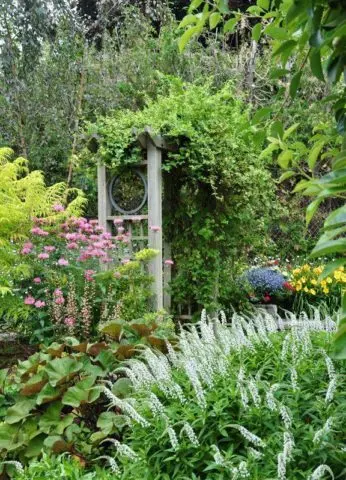
Firecracker – late variety, blooms from August to September
loosestrife lily of the valley
One of the rarely seen varieties of loosestrife is considered to be cletra-like or lily-of-the-valley. Distribution area – Primorsky Krai, less often the Far East. This is a good option for creating white gardens. It grows only in the shade on wet soil. The bush is tall, very dense, with intensive stem formation. The flowers are milky white, form a lush pyramidal inflorescence up to 30 cm tall with a drooping crown.
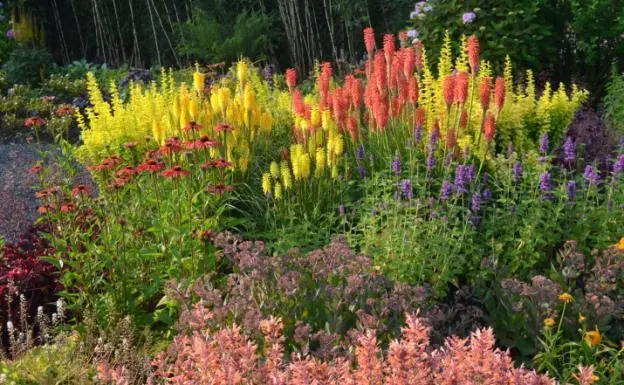
During flowering, the loosestrife bush attracts many butterflies with its aroma.
Based on a wild culture, the Lady Jane variety was created. The bush is denser up to 85 cm tall, the leaves are narrow, collected in whorls. Inflorescences are longer (up to 35 cm) and lush. The flowers are white with a pinkish tint, red or crimson core.

Lady Jane is distinguished by late flowering: from August to the end of September
Loosestrife dark purple
In the natural environment, this species of loosestrife is rare, it can be found in the northern latitudes. Beaujolais is grown in gardens, a rare seedless cultivar with dark purple flowers that form from the base of the stem and along its entire length. Shrub 40 cm high, compact, leaf plates are located at the bottom, oblong, with a blue tint.
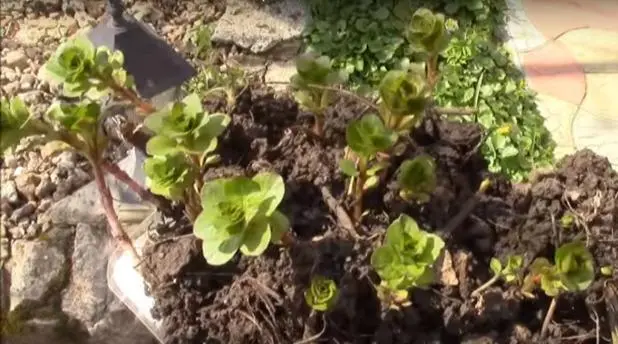
Beaujolais grows only on soil with stagnant water, blooms in the second year
loosestrife ephemerum
In nature, distributed in the Far East. Ephemerum is known as Daurian loosestrife. The plant is endowed with medicinal properties. It is rare in ornamental gardening. The plant forms a loose bush with long (up to 80 cm) stems, completely covered with small light red buds. When blooming, the petals appear white with a slight pink tint. The field species does not have an ornamental variety.
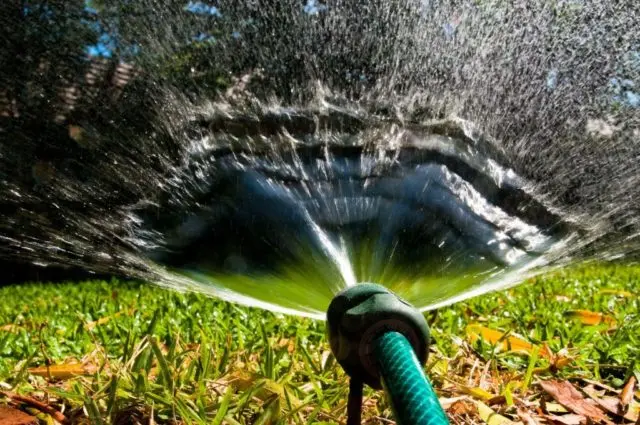
The loosestrife ephemerum is propagated on the site only vegetatively, the plant does not produce seeds
loosestrife oak
The natural form of the wild-growing species is quite decorative – it is a ground cover plant with a height of 15-20 cm. The branches are outstretched, smooth, without root processes. The leaves are rounded, large, collected in rosettes, have a bright green color. The plant completely covers the soil with a dense green carpet. The flowers are solitary, formed on tall pedicels, rarely scattered over the crown. Petals are bright yellow with beige anthers.
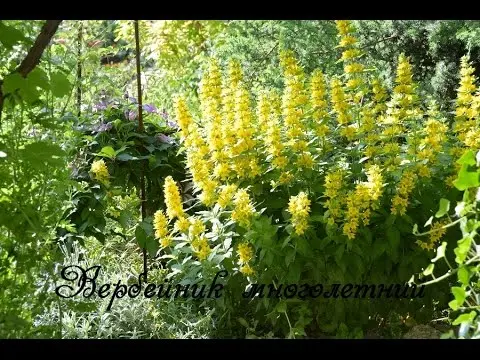
Dubravny – the earliest variety that blooms in mid-May and delights with its beauty until the end of July
loosestrife
The racemose loosestrife is a perennial plant listed in the Red Book as an endangered species. It is found in Siberia, Kamchatka, Chukotka, the Urals. Does not grow in warm climates. In design, they are used to decorate the banks of artificial reservoirs.
A plant with a powerful branched root, giving single shoots, not collected in a bush. The height of the stems is up to 1 m. The leaves are formed from the middle of the shoot. Inflorescences – rounded yellow brushes on long peduncles, growing in the upper part of the leaf axils.
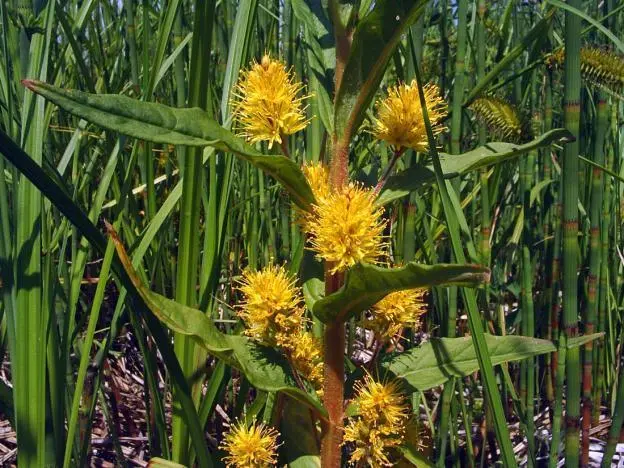
The racemose variety is often found in shallow stagnant water bodies (closer to the shore)
The use of loosestrife in the landscape
A few examples with photos of the use of flowers of perennial loosestrife varieties in a flower bed and territory design:
- planted for landscaping rock gardens and rockeries;

- in the foreground there are rabatkas near the fence;

The loosestrife is in harmony with tall plants with blue or blue color of inflorescences.
- to create a corner of the wild;

- for the design of park areas;

- the culture is included in compositions in flower beds;

- to delimit sections of the flower bed;

A creeping variety of loosestrife with a bright crown color emphasizes the color zones
- as a lawn cover near the garden path;

The ground cover loosestrife covers the ground with a solid carpet, preventing weeds from growing
How can you propagate loosestrife
To propagate a species plant, all methods are suitable. When breeding from seeds, there is no guarantee that the culture will fully retain the appearance of the mother plant. More often use the vegetative method or dividing the bush.
Seeds
Collect material after its ripening in the fall. You can immediately sow in open ground, the seeds will undergo natural stratification and sprout in the spring, loosestrife will bloom only after 2 years. Planting can be carried out in the spring in the last days of May, after placing the material for 2 weeks in the refrigerator.
The generative method is possible with the help of seedlings. Seeds are planted in a fertile substrate in February, the container is covered with a transparent material and left at a temperature of + 150C. After the appearance of the shoots, it is dived into separate containers and transplanted to the site in the spring.
Cuttings
Cuttings are a possible, but not productive, method; gardeners rarely use them. Cuttings are harvested from the middle part of the shoots before budding. The material is placed in water until the appearance of root processes. Then they are placed in the ground in a shaded place, arcs are installed and covered with a film to create a constantly high humidity, periodically the covering material is removed for air circulation. In autumn, rooted seedlings are planted in a designated place, covered for the winter.
By dividing the bush
The best breeding option, a well-grown loosestrife bush no younger than three years old is suitable for it. Work is carried out in the spring after the appearance of the first shoots.
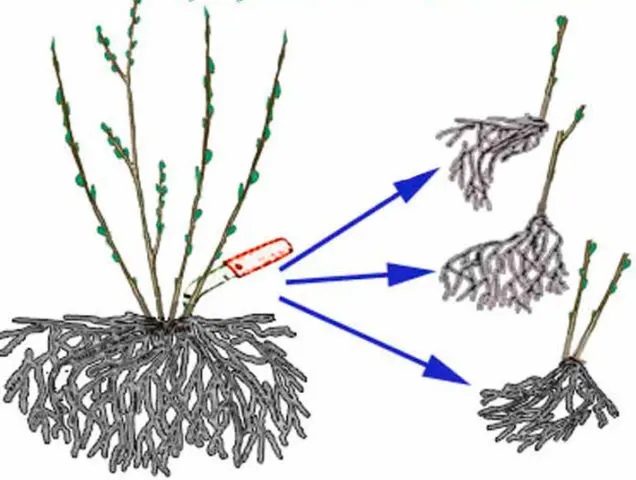
The plant is dug up, carefully divided into parts so that there are several vegetative buds on each plot
Ground cover varieties reproduce well by rooted layering.
Planting and caring for loosestrife in the open field
Loosestrifes are completely unpretentious if they are provided with conditions that meet biological requirements. Subject to the planting dates and the right place, there will be no problems with growing.
When to plant loosestrife
Landing time depends on the weather conditions of the region, the earth should warm up to +150C. Seedlings are placed on the site in early or mid-May. By autumn, loosestrife will take root and easily overwinter.
The division of the bush is carried out after flowering or in the spring, when the soil condition allows you to dig out the plant.
Where to plant loosestrife
Varieties of loosestrife with bright colors of flowers and leaves are best identified in a lighted or periodically shaded place. Varieties with white inflorescences only in the shade, burns are possible in the open sun, the flowers dry, and the plant loses its decorative appearance. Ground cover varieties with green foliage feel good in the shade, varieties with a golden color without ultraviolet lose their decorative qualities.
The composition of the soil is slightly acidic, fertile, the root system is superficial, soil aeration does not play a role.
In arid regions, regular root watering is necessary.
How to plant loosestrife
For planting a crop, a pit is not prepared in advance. On the day of work, peat and compost are mixed in equal parts.
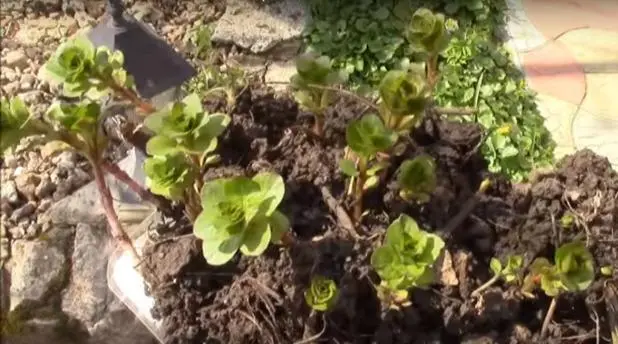
Dry areas are cut off from the root and planted together with an earthen clod
Landing:
- The depth of the hole is 10 cm, the width is determined by the volume of the root.
- 4 kg of substrate are poured onto the bottom.
- They put the plant and fall asleep together with the vegetative buds with the rest of the mixture.
Water thoroughly and mulch.
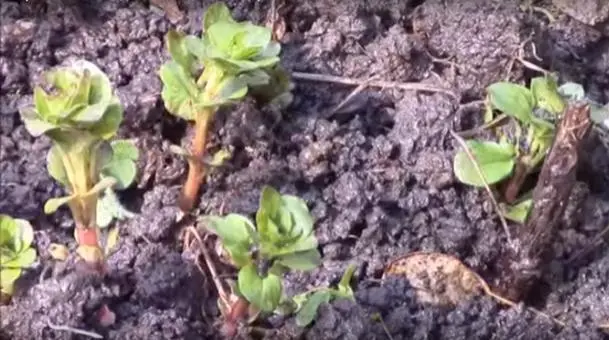
If there are young shoots, they are left on the surface.
Verbena transplant
If the loosestrife displaces more valuable cultivated plants or the place for the species is not chosen correctly, the bush is transferred to another site. In other cases, a transplant for culture is not needed.
When can you transplant loosestrife
You can transplant loosestrife in the spring, before budding, but at this time there are some disadvantages: it will not be possible to work early, because the earth is not warm enough. After the transfer, the adaptation period may affect flowering, it will not be very plentiful, in some cases the culture will not bloom at all. The optimal transplant time is when the plants have faded, so the time depends on the variety. The procedure is carried out in the fall, but no later than September.
How to transplant loosestrife to another place
In a culture, the root system is not deepened, but has grown strongly; it will not work to transplant varieties without damaging the root. The main thing is not to damage the young shoots.
How to move a bush to another site:
- The stems are pulled together with a rope so that they do not fall apart, this also applies to the bush and ground cover forms of the culture.
- They retreat about 25 cm in a circle, deepen on the bayonet of a shovel, carefully dig out a bush.
- A fabric or polyethylene is spread nearby and, by transshipment, the plant is moved to the material along with the ground.
- The hole is dug according to the size of the lump so that it fits snugly into the recess.
Features of growing loosestrife
All varieties and varieties quickly increase the root mass, during the season it can increase by 2 times. The plant is absolutely unpretentious if the place is properly allotted. Varietal representatives are less stress-resistant; in order to maintain a decorative form, it is necessary to comply with agricultural technology.
Watering and fertilizing schedule
Top dressing is done in the spring with nitrogen-containing agents necessary for intensive growth of green mass. Tall shrubs during flowering are fertilized with “Agricola”, for ground cover varieties this top dressing can be omitted. To lay new buds in the fall, organics are introduced.
Watering depends on the location, in a wetland or near a reservoir, the culture is not watered, the root system will fully provide the plant with moisture.
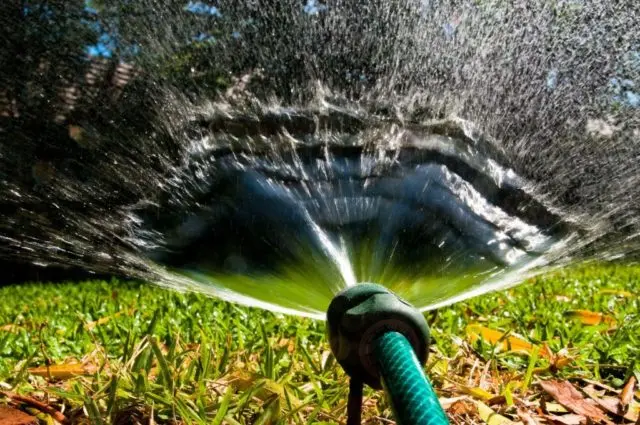
On a dry site, you will have to moisten every day, covering the area around the loosestrife up to 2 m
Weeding, loosening, mulching
Mulching is mandatory for the crop, the cover material retains moisture, and the layer is renewed in the spring. Weeding is necessary for seedlings; weeds do not grow under adult ground cover bushes. Loosening is carried out if there is no mulch, the procedure is relevant only for young crops. Aeration for plants older than 3 years is not essential.
Rules for pruning loosestrife
Regardless of the shape of the bush, loosestrife must be completely cut off for the winter. But this should not be done too early, the plant forms vegetative buds for replacement and it does not need extra stress. The shrub in autumn changes the color of the crown to bright yellow, so it does not lose its aesthetics. The stems are harvested before frost, leaving 5 cm above the ground.
How to prepare loosestrife for winter
The loosestrife is a culture of the Northern regions with high frost resistance; wild species can winter without additional measures. Ornamental bushes feed and increase the layer of mulch. Young seedlings spud, add organic matter, cover with straw or peat.
Pests and diseases
The loosestrife is characterized by strong immunity, the plant rarely gets sick. For the main garden pests, the herbaceous shrub is of no interest. The only insect that parasitizes on the crown is the aphid. If a pest is found, the areas of the main accumulation are cut off and treated with the Calypso preparation.
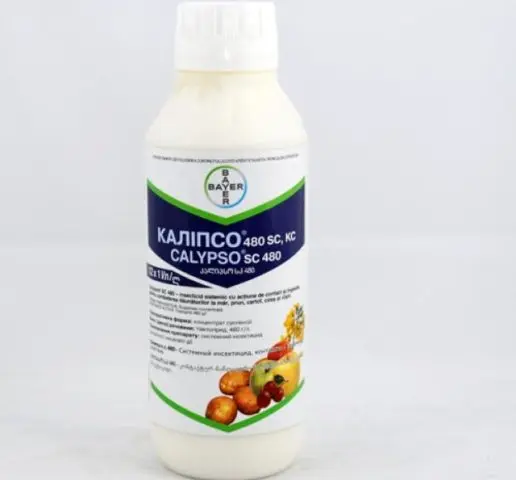
The effect of insecticide treatment is noticeable after 2 hours
Conclusion
Planting and caring for loosestrife is a simple procedure, the plant is unpretentious, with a high survival rate. The main condition for a full-fledged vegetation is increased soil moisture, this applies to all varieties and types. Herbaceous shrub is characterized by low drought tolerance. When planting a crop, it must be taken into account that this is an aggressor plant that will displace all representatives of the flora within a radius of 2-3 m.










